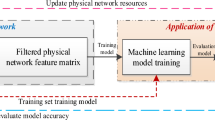Abstract
Virtual network embedding (VNE) refers to allocating reasonable substrate network resources for virtual network (VN) requests that include computing resources and network resources, so as to obtain optimal income from leasing virtual resources. Such a way of providing virtual resources is the key technology of cloud computing and can greatly save the operating cost of enterprises and provide flexibility of application deployment. However, the existing VNE algorithms are mostly oriented to traditional stochastic network topologies. Due to the high connectivity and server density of data centers and the complexity of the user’s resource requirements, the traditional VNE algorithms suffer from low resource utilization rate and revenues in the VNE on the data centers. Different from the existing algorithms which are often based on heuristic algorithms, this paper proposes a VNE algorithm for data center topology based on the Q-learning algorithm which is a typical reinforcement learning method. The algorithm an agent for each VN designs a reward function related to the effect of virtual link embedding, which is used to update the Q-matrix through unsupervised learning process. Then, the agent can find the optimal embedding strategy based on the Q-table from each learning. Simulation results demonstrate that the proposed algorithm can improve the resource utilization ratio and obtain a better revenue/cost ratio of the substrate network compared with the traditional heuristic algorithms.










Similar content being viewed by others
References
Lu FF, Xie XH, Guo DK et al (2017) Modular network structure for building mega-modular data center. J Softw 28(8):2196–2213
Yang J, Wang GY, Liu Q et al (2018) Retrospect and prospect of research of normal cloud model. Chin J Comput 3:724–744
Wang C, Liu G, Peng S et al (2017) Virtual network embedding with pre-transformation and incentive convergence mechanism. Concurr Comput Pract Exp 29(14):1–21
Zheng HK, Li JJ, Gong YJ, et al (2017) Link mapping-oriented ant colony system for virtual network embedding. In: IEEE congress on evolutionary computation, pp 1223–1230
Truong-Huu T, Gurusamy M (2017) Markov chain based algorithm for virtual network embedding in optical data centers. In: IEEE international conference on high performance computing and communications, pp 899–906
Fischer A, Botero JF, Beck MT et al (2013) Virtual network embedding: a survey. IEEE Commun Surv Tutor 15(4):1888–1906
Lu J, Turner J (2006) Efficient mapping of virtual networks onto a shared substrate, WUCSE-2006-35. Department of Computer Science and Engineering, Washington University, Washington
Pathak I, Vidyarthi DP (2015) An optimal virtual network mapping model based on dynamic threshold. Wirel Pers Commun 3:1–21
Zhang P, Yao H, Liu Y (2016) Virtual network embedding based on the degree and clustering coefficient information. IEEE Access 4:8572–8580
Ogino N, Kitahara T, Arakawa S, Murata M (2017) Virtual net- work embedding with multiple priority classes sharing substrate resources. Comput Netw 112:52–66
Liao J, Feng M, Qing S, Li T, Wang J (2016) Live: learning and inference for virtual network embedding. J Netw Syst Manag 24(2):227–256
Gong S, Chen J, Zhao S, Zhu Q (2016) Virtual network em-bedding with multi-attribute node ranking based on TOPSIS. In: KSII transactions on internet and information systems, vol 10
Zhu F, Wang H (2015) A modified ACO algorithm for virtual network embedding based on graph decomposition. Comput Commun 80:1–15
Hu Y, Zhuang L, Lan J et al (2016) Energy aware virtual network embedding using particle swarm optimization algorithm based on adaptive cooperative coevolution. J Electron Inf Technol 38(10):2667–2673
Zhang P, Yao H, Fang C, Liu Y (2016) Multi-objective enhanced particle swarm optimization in virtual network embedding. EURASIP J Wirel Commun Netw 2016(1):167
Zhangbao Z, Cheng X, Su S et al (2013) A unified enhanced particle swarm optimization-based virtual network embedding algorithm. Int J Commun Syst 26(8):1054–1073
Zhang Q, Lin M, Yang LT, et al (2017) Energy-efficient scheduling for real-time systems based on deep Q-learning model. In: IEEE transactions on sustainable computing, vol 99, p 1
Cherkassky BV, Goldberg AV, Radzik T (1996) Shortest path algorithms: theory and experimental evaluation. Math Program 73(2):129–174
Calheiros RN, Ranjan R, Beloglazov A et al (2011) CloudSim: a toolkit for modeling and simulation of cloud computing environments and evaluation of resource provisioning algorithms. Softw Pract Exp 41(1):23–50
Vahdat A, Al-Fares M, Loukissas A (2013) Scalable commodity data center network architecture: US, US8483096
Yang AM, Yang XL, Chang JC, Bai B, Kong FB, Ran QB (2018) Research on a fusion scheme of cellular network and wireless sensor for cyber physical social systems. IEEE Access 6(1):18786–18794
Lu DJ, Huang XX, Zhang GJ, Zheng XW, Liu H (2018) Trusted device-to-device based heterogeneous cellular networks: a new framework for connectivity optimization. IEEE Trans Veh Technol 67(11):11219–11233
Zhou X, Liang X, Du X, Zhao J (2018) Structure based user identification across social networks. IEEE Trans Knowl Data Eng 30(6):1178–1191
Koley E, Verma K, Ghosh S (2017) A modular neuro-wavelet based non-unit protection scheme for zone identification and fault location in six-phase transmission line. Neural Comput Appl 28:1369. https://doi.org/10.1007/s00521-016-2566-3
Li X, He JM, Hou BJ, Zhang PY (2018) Exploring the innovation modes and evolution of the cloud-based service using the activity theory on the basis of big data. Clust Comput 21(1):907–922
Acknowledgements
This work was supported by the National Natural Science Foundation of China under Grant No. 61702089, the Basic scientific research operating fund of central universities under Grant No. N182304021 and the Scientific research plan for institutions of higher learning of Hebei province under Grant No. ZD2019306.
Author information
Authors and Affiliations
Corresponding author
Ethics declarations
Conflict of interest
There are no conflicts of interests of this paper.
Additional information
Publisher's Note
Springer Nature remains neutral with regard to jurisdictional claims in published maps and institutional affiliations.
Rights and permissions
About this article
Cite this article
Yuan, Y., Tian, Z., Wang, C. et al. A Q-learning-based approach for virtual network embedding in data center. Neural Comput & Applic 32, 1995–2004 (2020). https://doi.org/10.1007/s00521-019-04376-6
Received:
Accepted:
Published:
Issue Date:
DOI: https://doi.org/10.1007/s00521-019-04376-6




